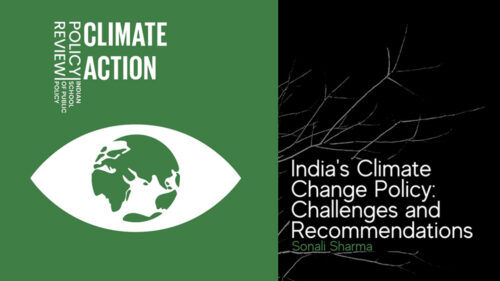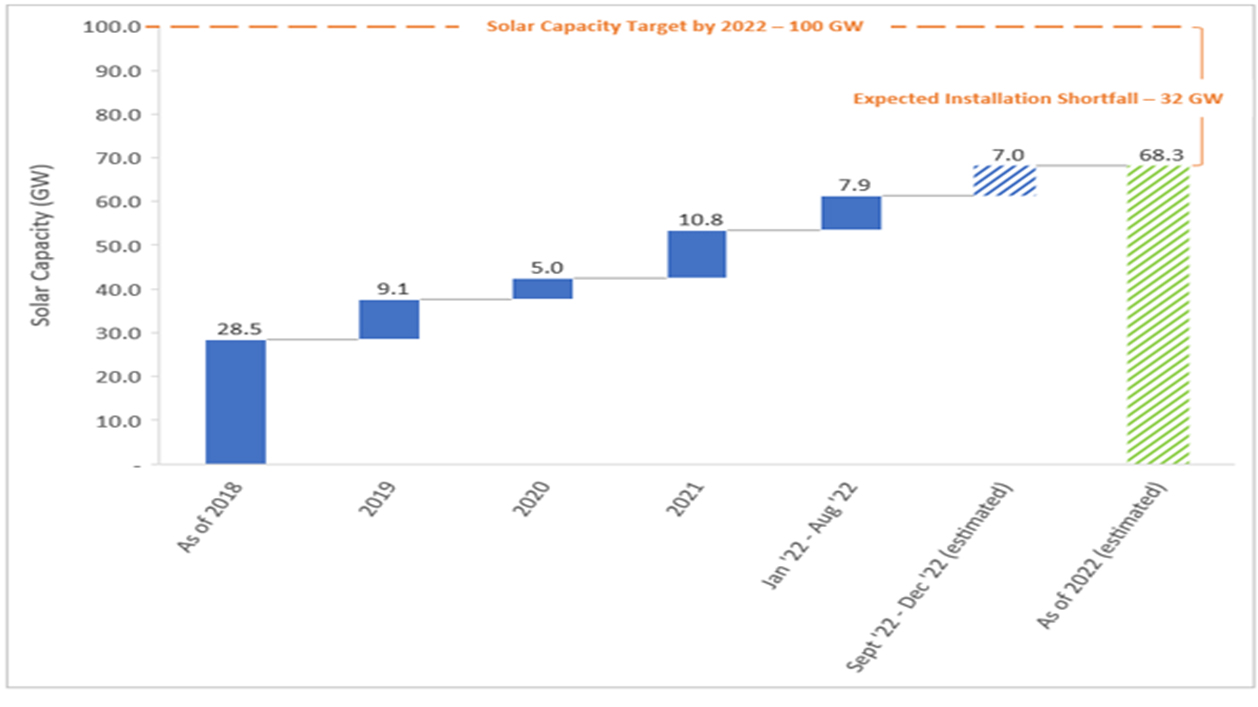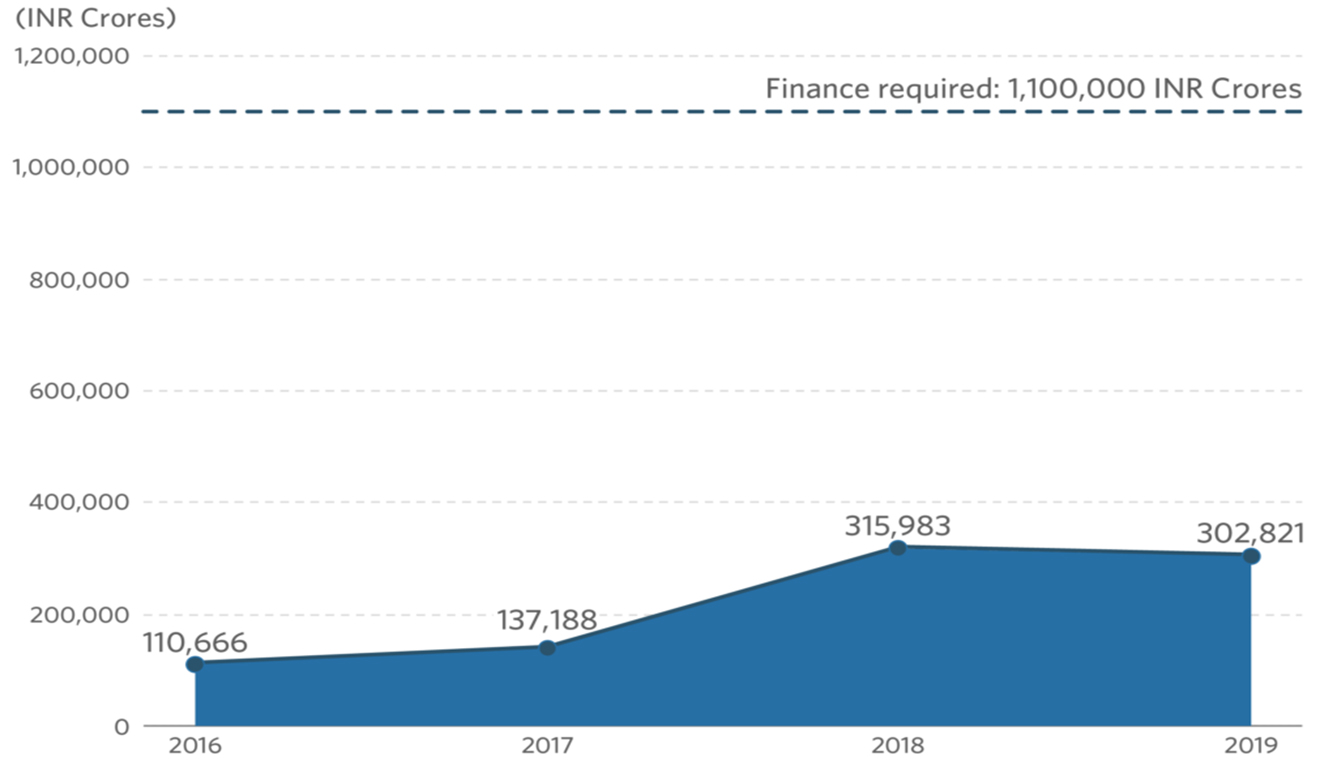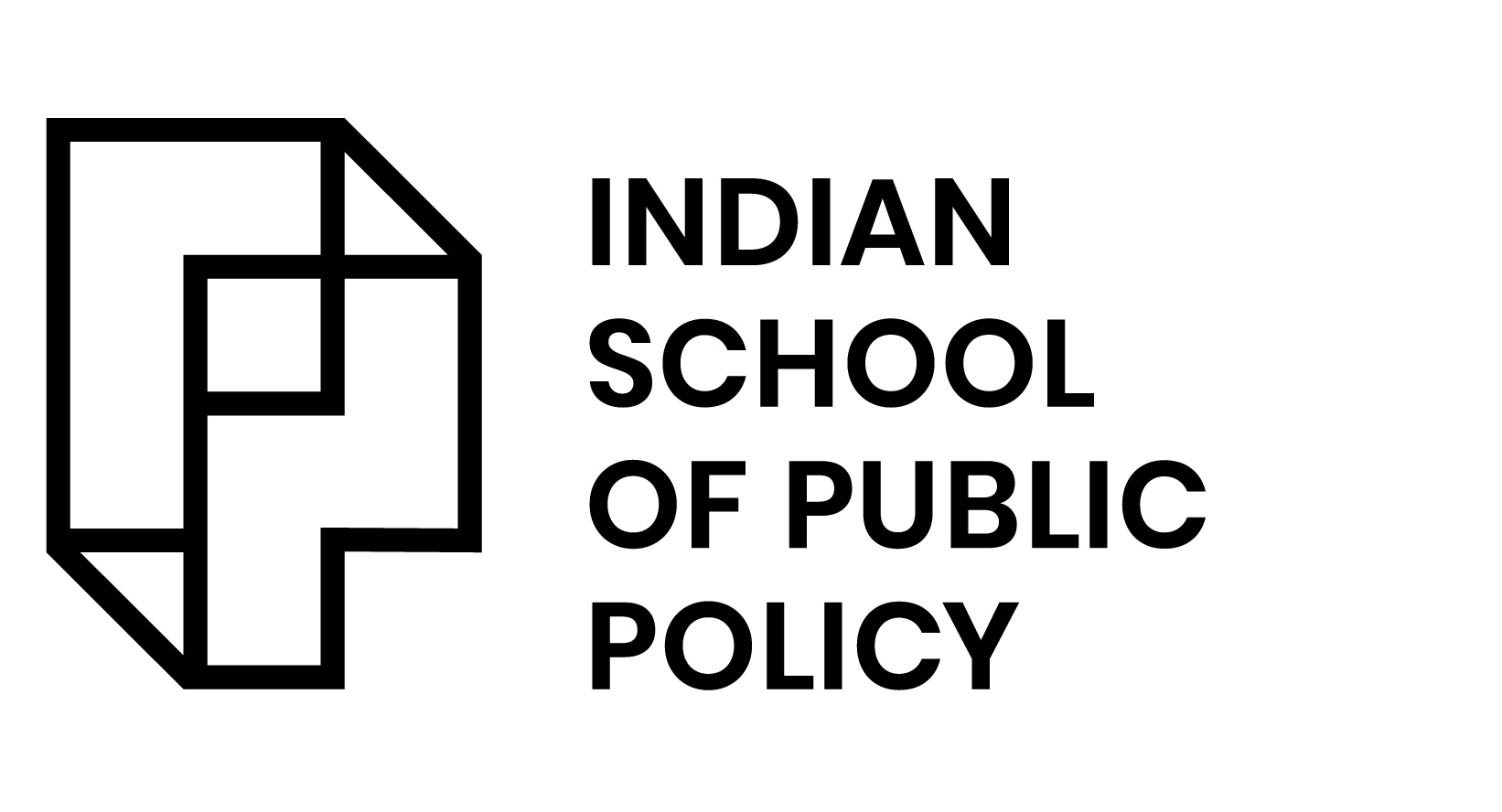
India’s Climate Change Policy: Challenges and Recommendations

Introduction
India is susceptible to wide scale climate change-related risks due to its various climate zones, topography, and ecosystems. The Global Climate Risk Index 2021i calls India the 7th most affected nation due to climate change. As per the State of India’s Environment in Figures 2022ii India reported 280 heatwave days (the highest in 12 years) between the period 11th March – 18th May 2022.
Climate change exposes vulnerable communities to dangers like disasters, diseases, loss of livelihoods, crop failures, poverty and displacement, threatening loss of biodiversity and food securityiii .
International pressure for urgent climate action heightened when the first legally binding international treaty, the Kyoto Protocol containing the GHG reduction targets, came into effect in 2005. Thereafter, increased emphasis was laid upon domestic policy for climate change both at the national and state government levels along with private and civil society groupsiv
Brief history of India’s current climate change policy
Climate change policies in India have primarily focused on supporting synergies between development and outcomes for the climate. India was one of the few countries that passed the Energy Conservation Act in 2001 which underwent an amendment in August 2022. Some changes include consumers meeting their energy needs from non-fossil sources, application of the Energy Conservation Building Code (ECBC) to office and residential buildings for loads equal to or more than 100 KW, and specification of energy consumption standards for ships and vehicles.
India has developed its policy response through missions and programmes to reduce its climate vulnerability. On 30th June 2008, the National Action Plan on Climate Change (NAPCC)v was released. It is a national strategy of 8 sub-missions to help adapt and magnify ecological sustainability in India’s development path. These are National Solar Mission (NSM), National Mission for Enhanced Energy Efficiency (NMEEE), National Mission on Sustainable Habitat (NMSH), National Water Mission (NWM), National Mission for Sustaining the Himalayan Ecosystem (NMSHE), National Mission on Strategic Knowledge for Climate Change (NMSKCC), National Mission for a Green India (GIM), and National Mission for Sustainable Agriculture (NMSA).
On 3 August 2022, the Union Cabinet under the Chairmanship of the Prime Minister passed the updated Nationally Determined Contribution (NDC) for consideration by the United Nations Framework Convention on Climate Change (UNFCCC) under the Paris Agreement, to reach India’s goal of net zero emissions by 2070. This was a translation of the Panchamrit (five nectar elements) – India’s action plan against climate change, announced at COP 26 in Glasgow, United Kingdom.
| Quantified Goals | Non-Quantified Goals |
|---|---|
| To reduce the emissions intensity of its GDP by 45 per cent by 2030, from the 2005 level. | To put forward and further propagate a healthy and sustainable way of living based on traditions and values of conservation and moderation, including through a mass movement for ‘LIFE’– ‘Lifestyle for Environment’ as a key to combating climate change. |
| To achieve about 50 per cent cumulative electric power installed capacity from non-fossil fuel-based energy resources by 2030, with the help of the transfer of technology and low-cost international finance including from the Green Climate Fund (GCF). | To adopt a climate-friendly and cleaner path than the one followed hitherto by others at the corresponding level of economic development. |
| To create an additional carbon sink of 2.5 to 3 billion tonnes of CO2 equivalent through additional forest and tree cover by 2030. | To better adapt to climate change by enhancing investments in development programmes in sectors vulnerable to climate change, particularly agriculture, water resources, the Himalayan region, coastal regions, and health and disaster management. |
| To mobilize domestic and new & additional funds from developed countries to implement the above mitigation and adaptation actions in view of the resource required and the resource gap. | |
| To build capacities, create a domestic framework and international architecture for quick diffusion of cutting-edge climate technology in India and joint collaborative R&D for such future technologies. |
Source: PIB, Government of India
The updated NDCs give the country clear instructions on how to separate economic growth from greenhouse gas emissions. The changes are made given the national scenario and the fundamentals of common but differentiated responsibilities along with corresponding competencies. It is possible to achieve the Sustainable Development Goals (SDGs) as well as a reduction in carbon emissions by implementing the NDC.
Also read: Why Study Public Policy? What Makes It Important Now More Than Ever?
Current challenges in India’s climate policy
For the Energy Conservation (Amendment) Bill 2022vi , the Ministry of Power (MoP) is appointed as the nodal Ministry and the Bureau of Energy Efficiency (BEE) as the implementing agency. However, the question arises whether the MoP will be the right body to regulate the scheme. As per the Business Allocation Rules, it is the MoEFCC that looks into climate change matters and environmental norms. In countries such as the UK and the US, it is the Environment Ministry that implements the schemes as proposed by the Bill. There is no clarity as to who will regulate the carbon credit certificates as mentioned in the Act. The interchangeability of certificates is not clearly defined as the same activity may be applied to energy savings, renewable energy, and carbon credits.
Till now, India has installed 6.7 GW of solar rooftop panelsvii which is quite less compared to its target of 40 GW in 2022viii . An overall shortfall of 32 GW is expected in reaching the target of 100 GW solar capacity by 2022. As per the report, The State of Renewable Energy in India 2019 by the Center for Science and Environment, New Delhi, inconsistent policies, underperformance of distribution companies, rise in subsequent tariffs, and more interest towards large-scale renewable energy are some of the reasons for this failure. The slow pace is a result of more preference being given to industrial and commercial sectors over the residential domain.
Progress in India’s solar power capacity

Source: Economic Times
The Green India Mission meant to revive forests through afforestation activities has fallen short of its objectives by 30% from 2015-16 to 2020-21. States like West Bengal, J&K, and Himachal Pradesh have not yet become a part of this scheme.
State-wise targets and achievements under Green India Mission from FY 2015-16 to FY 2020-21
| S.No. | States | Advance work Target (ha) | Creation of Plantation Achievement (ha) |
|---|---|---|---|
| 1. | Andhra Pradesh | 2737 | 1433 |
| 2. | Chhattisgarh | 20191 | 19128 |
| 3. | Himachal Pradesh | 5480 | – |
| 4. | Jammu & Kashmir | 5680 | – |
| 5. | Karnataka | 1920 | 1920 |
| 6. | Kerala | 12298 | 9015 |
| 7. | Madhya Pradesh | 23358 | 19470 |
| 8. | Maharashtra | 6766 | 5224 |
| 9. | Manipur | 16920 | 11740 |
| 10. | Mizoram | 19643 | 19643 |
| 11. | Odisha | 16634 | 16634 |
| 12. | Punjab | 4304 | 4304 |
| 13. | Sikkim | 1509 | 1509 |
| 14. | Uttarakhand | 11045 | 7483 |
| 15. | West Bengal | 18666 | – |
| Total | 167151 | 117503 | |
Source: MoEFCC
The NWM does not address the issue of equity as the demand for water among affluent people is more, which has reduced the per capita availability of water for lower sections. Furthermore, NMSHE faces major challenges like shortage of manpower, financial constraints, technical issues, and lack of coordination among research institutions and ministries. In the case of NMSKCC, the involved states are yet to set up nodal agencies, climate networks, capacity-building initiatives, and data-sharing systems. A secure payment mechanism remains absent for such institutions which host energy efficiency projects. NMEEE also suffers from poor knowledge exchange between energy suppliers and consumer sectorsix
New schemes such as AMRUT, HRIDAY, Smart City Mission, National Urban Livelihood Mission, and Swachch Bharat focus on concentrated areas with their objectives overlapping with the National Mission for Sustainable Habitat. These new schemes have drawn more attention than the NMSH. A few main guidelines for transport, energy efficiency, and sustainable habitat are yet to be incorporated into the urban planning process. There are major gaps in the National Mission for Sustainable Agriculture (NMSA) which includes less focus on small and marginal farmers for climate change resilience and less attention to adaptation scenarios. Also, the success of NMSA depends upon its integration with other national programmes on agriculture, development, and food security like MNREGA, National Food Security Mission, and Farm Management Mission among others. It is a long and tedious task as most of these fall under different ministries, making coordination difficult.
According to the Economic Survey 2020-21x , to achieve India’s Nationally Determined Contribution goals, a financial resource of USD 2.5 trillion (INR 11 lakh crores) at 2014-15 prices is needed. The graph below clearly depicts the gap in obtaining climate finance for NDC on India’s part.

Source: Climate Policy Initiative
Climate finance is necessary to fulfil NDC targets. By 2020, developed nations were to provide USD 100 billion to developing countries which did not happen. Moreover, IFSCA Expert Committee on Sustainable Finance estimated that India needs investments of $10 trillion to make the carbon neutrality story a success by 2070. However, the Climate Policy Initiative (CPI) reported that India could raise only $44 billionxi (25% of the total target required each year) in FY 2019-20. The international investment was 13% and 17% in 2019 and 2020 respectively which is less due to the 5% hedging cost in the region. Due to the absence of a proper green finance taxonomy and casual reporting of data, domestic entries are tagged arbitrarily and are subject to the user’s discretion.
Register your Interest to Study at ISPP
Key Recommendations
- India needs to see climate change as a risk to development. States should come forward to assume leadership in their efforts to attain the State Action Plan on Climate Change (SAPCC) which on a broader level adds to NAPCC. In this context, Chhattisgarh has started many cross-sectoral initiatives like Narva (rivers and streams), Ghurva (compost pit), Garva (livestock), and Bari (backyard farming). These along with the health department’s target to achieve net zero emissions is a great exhibition of state-level climate leadership. Under such initiatives, priority areas like forest, livelihood, climate resilient agriculture, decarbonisation of transport and industry are covered.
- Lack of political will inhibits making climate change a priority for the political class. It must be understood that climate change impacts can jeopardize objectives of economic growth and poverty reduction. As such there should be more attempts to motivate political willingness.
- Institutional bottlenecks act as barriers to successful implementation of climate policies. Within the nodal departments, climate change knowledge management cells have been created to look after the coordination blockages. These must be strengthened with nodal officers working as a focal point for coordination among ministries and departments.
- Till April 2021, $29.02 billion has been allocated to promote high (coal?) production as well as consumption. This continued attention to coal jeopardizes efforts to pursue cleaner forms of energy. The government and public support for coal must be ended and electricity distribution systems must be improved
- The natural carbon-rich ecosystems such as forests and wetlands should be conserved and enhanced which in turn can boost agricultural productivity and sequester carbon dioxide .
- Initiatives like the Indo-German Energy Forum (IGEF) established in 2006 to increase Indo-German cooperation in renewable energy, investment, and research and development in energy projects must be encouraged for long-lasting sustainable environmental development through R&D.
- India needs to expand its take on solar energy. Alternatives to solar ground mount projects like floating solar and offshore wind projects should be encouraged. These do not require large land areas and provide high energy yield. To advance its non-fossil fuel base India must develop a wider energy storage system. However, this heavily relies on the lithium battery supply chain which is a challenge to obtain owing to the global lithium market situationxiv .
- Climate investment planning can be understood in 3 aspects knowing planning capacity, identifying the needs of investment, and mobilizing it. Jordan has set up a sector working group consisting of development partners, representatives of ministries, and civil society who have identified 35 priority actions based on criteria like impact, gender and vulnerability issues, sustainable development potential, and readiness India should learn from this and support project development in the early stages and should assist project developers to get proper funding opportunities to decrease the funding gapxv .
- Other steps which India needs to take include: developing sectoral investment and private sector engagement plans in support of NDC, strengthening national sector capacities to access and coordinate climate finance, increasing engagement of industry and financial decision-makers in the NDC process (both partnerships and project development), create political leadership with the private sector and showcase mutual advantages to elevate ambitionxvi .
Conclusion
In 2020, India was the third biggest emitter of GHGsxvii . As per climate analysts, India will not hit the peak of emissions by 2030, but instead, achieve the same between 2040-2045. This trend may create hindrance for India’s energy transition plans for the second half of this century. A pragmatic and far-sighted approach is necessary. Coal, a major player in India’s energy sector, needs to be regulated and a shift towards green energy must be made to assist India in its renewable energy conversion goal. Forests which are carbon sinks need sustainable management from cooperative efforts of local communities and government. Financial, political, and policy leadership lies at the bottom of all the recommendations for a thriving climate change policy for India. Regional, state, national, and global involvements are the most effective keys for India to meet its aspirations of a climate resilient planet and achieve long-term sustainable growth.
References
- Eckstein D., Kunzel V., Schafer L. (2021). Global Climate Risk Index 2021. GermanWatch.
- Bello L. (2022, June 27). Rooftop solar: The missing piece of India’s renewable ambitions. The Third Pole.
- Byravan S., Rajan S. (2012). An Evaluation of India’s National Action Plan on Climate Change. Center for Development Finance (CDF), IFMR, and Humanities and Social Sciences, IIT Madras.
- Department of Economic Affairs, Ministry of Finance. (2020). Report of the Sub-Committee for the Assessment of the Financial Requirements for Implementing India’s Nationally Determined Contribution (NDC). Government of India.
- Gap between resource availability, requirement pose challenge in NDC implementation: Eco Survey. (2021, Jan 29). Economic Times.
https://economictimes.indiatimes.com/news/economy/policy/gap-between-resource-availability-requirement-pose-challenge-in-ndc-implementation-eco-survey/articleshow/80590515.cms - Jain S. (2021). Five Ways How India Can Fuel Its Ambitious Renewable Energy Drive. Outlook. https://www.outlookindia.com/website/story/business-news-five-ways-how-india-can-fuel-its-ambitious-renewable-energy-drive/403252
- Khanna N., Purkyastha D., Jain S. (2022, Aug 10). Landscape of Green Finance in India 2022. Climate Policy Initiative.
- Kumar P. (2022, Aug 10). Energy Conservation Amendment Bill 2022: It all boils down to targets for industries. Down To Earth.
https://www.downtoearth.org.in/blog/energy/energy-conservation-amendment-bill-2022-it-all-boils-down-to-targets-for-industries-84252 - Ministry of New and Renewable Energy
(https://mnre.gov.in/solar/current-status/) - Narasimhan E., Gopalakrishnan T., Gallagher K. (2021, Nov 11). India’s policy pathways for deep decarbonisation. Observer Research Foundation. https://www.orfonline.org/expert-speak/indias-policy-pathways-for-deep-decarbonisation/
- Pandey K. (2022, June 2). State of India’s Environment in figures: India recorded 280 heat wave days across 16 states in 2022 — most in decade. Down To Earth.
https://www.downtoearth.org.in/news/climate-change/state-of-india-s-environment-in-figures-india-recorded-280-heat-wave-days-across-16-states-in-2022-most-in-decade-83131 - Picciariello A., Colenbrander S., Bazaz A., Roy R. (2021). The costs of climate change in India – A review of the climate-related risks facing India, and their economic and social costs. ODI Literature Review.
- Rattani V. (2018). Coping with climate change – An analysis of India’s National Action Plan on Climate Change. Center for Science and Environment.
- RBI Bulletin. (2021). Green Finance in India: Progress and Challenges.
- Sami N., Singh C., Bazaz A. Climate Change Policy in India and Goal 13. Indian Institute of Human Settlements.
- View: Energy storage is the missing link in wider adoption of renewables. (2022, Apr 05). Economic Times. https://economictimes.indiatimes.com/industry/renewables/view-energy-storage-is-the-missing-link-in-wider-adoption-of-renewables/articleshow/90660853.cms?from=mdr
- Emissions Gap Report. (2022). United Nations Environment Programme.
End notes
- Eckstein D., Kunzel V., Schafer L. (2021). Global Climate Risk Index 2021. GermanWatch.
- Pandey K. (2022, June 2). State of India’s Environment in figures: India recorded 280 heat wave days across 16 states in 2022 — most in decade. Down To Earth.
- Picciariello A., Colenbrander S., Bazaz A., Roy R. (2021). The costs of climate change in India – A review of the climate-related risks facing India, and their economic and social costs. ODI Literature Review.
- Sami N., Singh C., Bazaz A. Climate Change Policy in India and Goal 13. Indian Institute of Human Settlements.
- Byravan S., Rajan S. (2012). An Evaluation of India’s National Action Plan on Climate Change. Center for Development Finance (CDF), IFMR, and Humanities and Social Sciences, IIT Madras.
- Kumar P. (2022, Aug 10). Energy Conservation Amendment Bill 2022: It all boils down to targets for industries. Down To Earth.
- Ministry of New and Renewable Energy
- Bello L. (2022, June 27). Rooftop solar: The missing piece of India’s renewable ambitions. The Third Pole
- Rattani V. (2018). Coping with climate change – An analysis of India’s National Action Plan on Climate Change. Center for Science and Environment.
- Gap between resource availability, requirement pose challenge in NDC implementation: Eco Survey. (2021, Jan 29). Economic Times.
- Khanna N., Purkyastha D., Jain S. (2022, Aug 10). Landscape of Green Finance in India 2022. Climate Policy Initiative.
- Jain S. (2021). Five Ways How India Can Fuel Its Ambitious Renewable Energy Drive. Outlook.
- Narassimhan E., Gopalakrishnan T., Gallagher K. (2021, Nov 11). India’s policy pathways for deep decarbonisation. Observer Research Foundation.
- View: Energy storage is the missing link in wider adoption of renewables. (2022, Apr 05). Economic Times.
- RBI Bulletin. (2021). Green Finance in India: Progress and Challenges.
- Department of Economic Affairs, Ministry of Finance. (2020). Report of the Sub-Committee for the Assessment of the Financial Requirements for Implementing India’s Nationally Determined Contribution (NDC). Government of India.
- Emissions Gap Report. (2022). United Nations Environment Programme
FAQs
How did the emphasis increase on domestic policy for climate change in India?
International pressure for urgent climate action heightened when the first legally binding international treaty, the Kyoto Protocol containing the GHG reduction targets, came into effect in 2005. Thereafter, increased emphasis was laid upon domestic policy for climate change both at the national and state government levels along with private and civil society groups
Why is having robust climate change policies necessary?
Climate change exposes vulnerable communities to dangers like disasters, diseases, loss of livelihoods, crop failures, poverty, and displacement, threatening loss of biodiversity and food security.
What update did the Union Cabinet under the Chairmanship of the Prime Minister pass on 3 August 2022?
On 3 August 2022, the Union Cabinet under the Chairmanship of the Prime Minister passed the updated Nationally Determined Contribution (NDC) for consideration by the United Nations Framework Convention on Climate Change (UNFCCC) under the Paris Agreement, to reach India’s goal of net zero emissions by 2070. This was a translation of the Panchamrit (five nectar elements) – India’s action plan against climate change, announced at COP 26 in Glasgow, United Kingdom.

